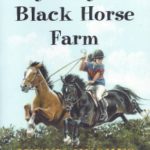Where was this book when I was a kid?

All I ever wanted was a good racing story that might explain to me the very adult world of horse racing, which always had its doors closed to children. We were relegated to velvet hunt caps, tasteful make-up, and natural fences to jump. I wanted rainbow-colored silks, dirt in my face, and a clear path to the wire.
The books I had were the classics, and I memorized them even as I bemoaned their reading level (Black Gold by Marguerite Henry and Come on, Seabiscuit! by Ralph Moody were amazing history lessons, but I wanted to know what racing life was like now).
I was always a skeptical child, and knew the American Jockey Club would never have permitted the Black to race, and certainly not to enter the Stud Book. (One might say the same thing of The Pie in National Velvet.) I wanted reality, I wanted some glimpse of the real thing–that storied world I wasn’t allowed to enter– not more history, not more fantasy, and certainly not more boys. Surely Velvet Brown (National Velvet) wasn’t the only girl that dreamed of galloping a fast horse!
At last, The Sweet Running Filly is the book I was looking for.
First published in 1971 and set in southern Ohio, everything about this book rings true, right down to the very skillful country voice that the narration and dialogue are written in. Oh sure, there are stereotypical characters–the scar-faced trainer that specializes in cheap claimers, the African-American groom that knows all the native flora and fauna and uses them in his secret remedies to keep the horses going, the wealthy farm owner, etc. But if Dick Francis wrote to a formula, I think we can excuse Filly author Barbara Van Tuyl hers. When the characters work, do you really care if you recognize them?
From the opener at the Fasig-Tipton Saratoga sales, a beautiful yearling spooks her way into the sales ring and rockets out again, a sales-topper of The Green Monkey (who sold for $16 million) proportions. Then it’s on to the Ohio antiques shop where Julie Jefferson holds up the counter for her father (a man of excellent wit, and their exchanges alone make the book worth your time). And finally it’s the summer Julie spends starting yearlings and learning to work horses. Through it all, The Sweet Running Filly captivates–and manages to stay within the realm of reality, a welcome gift for anyone tired of racing fantasy. Even the mystery, during which the main character reinvents herself as Julie Jefferson, Girl Detective, is fast-paced, entertaining, and not too convoluted.

Despite the rollicking, quick story, despite the excellent voice and witty dialogue, what really captures me are the truisms in this book that any horse-crazy girl will recognize:
“The common belief was that you loved horses because you loved riding. But Julie’s emotions worked the other way. She loved riding because she loved horses. Sitting astride a horse was just one expression of the closeness of two spirits, no more and no less satisfying than playing together in a grassy pasture; nuzzling in a warm, dark stall; hand-walking after a bath to dry out; or grooming on a pair of crossties snapped across a stable aisle.”
The Bonnie Books Series continues with a half-dozen more titles, including the currently available A Horse Called Bonnie. A percentage of the book sales will be going to Thoroughbred charities that work to improve the lives of retired racehorses. Find out more on Facebook (The Bonnie Books) and www.poppetpress.com.







